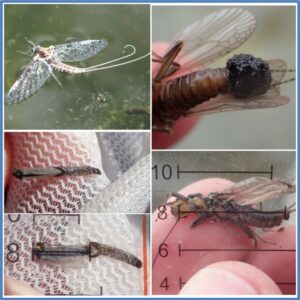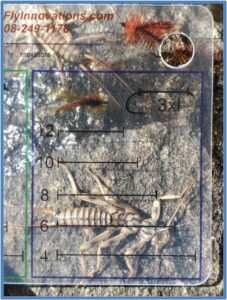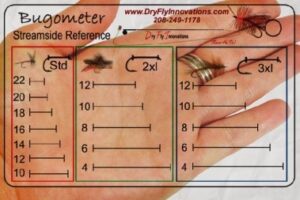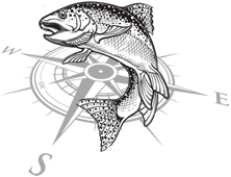10 Tips For Choosing A Fly
by Troy Pearse
When you get to the river, how do you decide what fly to use? Often anglers use a “lucky fly” or the fly that worked the last time they were out. And while that works sometimes, here are some tips that will up your odds of picking a fly that will catch more trout.
- Consult a hatch-chart before you head to the river and make sure your fly box is stocked to match what bugs will be hatching.
- Look for hatching bugs on the water or caught in back-eddies. Hatched bugs often will collect on the downstream side of boulders, be in riverside bushes or caught in spider webs.
- Fish can get picky during a hatch and gathering a bug-sample will pay BIG dividends. Use a small aquarium net, wade in below the rising fish and scoop up a sample. Choose a fly that matches the natural.
- Size is a critical aspect to match—Don’t Guess!! Measure the size of your bug-sample with a *Bugometer.
- Bugs are often 2-toned top/bottom so when matching fly color make sure to match the bottom side of the bug.
- Pay particular attention to the “phase” of the hatching bug as fish often key in on the hatch-phase. Figure 1 shows key things to look for: Does it have an emergent shuck like this midge? Does it have clear outspread wings like this Callibaetis mayfly spinner? Does it have an egg-sac like this Skwala?
- In summer terrestrials are especially important. Watch for grasshoppers bounding away as you walk along the banks. Pay attention to bank-side logs and look for ants and beetles. Cicadas are prevalent in many of our local rivers in June but you won’t usually see them. They like pine trees next to the river. Listen for the “cicada buzz” as your clue.
- If you see no adult or hatching bugs it’s time to look under the surface for clues. Slip a mesh bag over your landing net and kic
 k up the stream bottom in riffles to capture nymphs. Choose a fly that matches whatever nymph is most prevalent, making sure to measure bug size on your *Bugometer.
k up the stream bottom in riffles to capture nymphs. Choose a fly that matches whatever nymph is most prevalent, making sure to measure bug size on your *Bugometer. - Nymphs often give you a clue about what is about to hatch. Watch for Skwala nymphs next to the bank in Spring; Mayflies with dark wing-pads are ready to hatch; and Cased caddis stuck to rocks indicate a hatch is coming.
- When stoneflies hatch they leave their nymphal shuck behind on shoreline rocks. Look for them on rocks close to the current water-line to clue you in that a hatch has been going on. Choose a fly that matches the size of the shuck. Figure 2 shows a goldenstone shuck from the MF Boise river that translated into fish-in-the-net in early June.

*The Bugometer is an inexpensive plastic “bug ruler” that makes it easy to determine the size of a bug or your fly. Bugometers are only available through Dry Fly Innovations. Get yourself one and catch more trout! https://www.dryflyinnovations.com/products/the-bugometer

